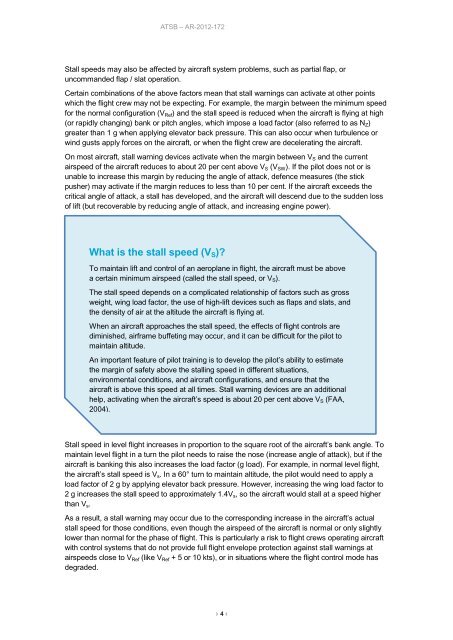Stall warnings in high capacity aircraft: The Australian context 2008 ...
Stall warnings in high capacity aircraft: The Australian context 2008 ...
Stall warnings in high capacity aircraft: The Australian context 2008 ...
You also want an ePaper? Increase the reach of your titles
YUMPU automatically turns print PDFs into web optimized ePapers that Google loves.
ATSB – AR-2012-172<br />
<strong>Stall</strong> speeds may also be affected by <strong>aircraft</strong> system problems, such as partial flap, or<br />
uncommanded flap / slat operation.<br />
Certa<strong>in</strong> comb<strong>in</strong>ations of the above factors mean that stall <strong>warn<strong>in</strong>gs</strong> can activate at other po<strong>in</strong>ts<br />
which the flight crew may not be expect<strong>in</strong>g. For example, the marg<strong>in</strong> between the m<strong>in</strong>imum speed<br />
for the normal configuration (V Ref ) and the stall speed is reduced when the <strong>aircraft</strong> is fly<strong>in</strong>g at <strong>high</strong><br />
(or rapidly chang<strong>in</strong>g) bank or pitch angles, which impose a load factor (also referred to as N Z )<br />
greater than 1 g when apply<strong>in</strong>g elevator back pressure. This can also occur when turbulence or<br />
w<strong>in</strong>d gusts apply forces on the <strong>aircraft</strong>, or when the flight crew are decelerat<strong>in</strong>g the <strong>aircraft</strong>.<br />
On most <strong>aircraft</strong>, stall warn<strong>in</strong>g devices activate when the marg<strong>in</strong> between V S and the current<br />
airspeed of the <strong>aircraft</strong> reduces to about 20 per cent above V S (V SW ). If the pilot does not or is<br />
unable to <strong>in</strong>crease this marg<strong>in</strong> by reduc<strong>in</strong>g the angle of attack, defence measures (the stick<br />
pusher) may activate if the marg<strong>in</strong> reduces to less than 10 per cent. If the <strong>aircraft</strong> exceeds the<br />
critical angle of attack, a stall has developed, and the <strong>aircraft</strong> will descend due to the sudden loss<br />
of lift (but recoverable by reduc<strong>in</strong>g angle of attack, and <strong>in</strong>creas<strong>in</strong>g eng<strong>in</strong>e power).<br />
What is the stall speed (V S )?<br />
To ma<strong>in</strong>ta<strong>in</strong> lift and control of an aeroplane <strong>in</strong> flight, the <strong>aircraft</strong> must be above<br />
a certa<strong>in</strong> m<strong>in</strong>imum airspeed (called the stall speed, or V S ).<br />
<strong>The</strong> stall speed depends on a complicated relationship of factors such as gross<br />
weight, w<strong>in</strong>g load factor, the use of <strong>high</strong>-lift devices such as flaps and slats, and<br />
the density of air at the altitude the <strong>aircraft</strong> is fly<strong>in</strong>g at.<br />
When an <strong>aircraft</strong> approaches the stall speed, the effects of flight controls are<br />
dim<strong>in</strong>ished, airframe buffet<strong>in</strong>g may occur, and it can be difficult for the pilot to<br />
ma<strong>in</strong>ta<strong>in</strong> altitude.<br />
An important feature of pilot tra<strong>in</strong><strong>in</strong>g is to develop the pilot’s ability to estimate<br />
the marg<strong>in</strong> of safety above the stall<strong>in</strong>g speed <strong>in</strong> different situations,<br />
environmental conditions, and <strong>aircraft</strong> configurations, and ensure that the<br />
<strong>aircraft</strong> is above this speed at all times. <strong>Stall</strong> warn<strong>in</strong>g devices are an additional<br />
help, activat<strong>in</strong>g when the <strong>aircraft</strong>’s speed is about 20 per cent above V S (FAA,<br />
2004).<br />
<strong>Stall</strong> speed <strong>in</strong> level flight <strong>in</strong>creases <strong>in</strong> proportion to the square root of the <strong>aircraft</strong>’s bank angle. To<br />
ma<strong>in</strong>ta<strong>in</strong> level flight <strong>in</strong> a turn the pilot needs to raise the nose (<strong>in</strong>crease angle of attack), but if the<br />
<strong>aircraft</strong> is bank<strong>in</strong>g this also <strong>in</strong>creases the load factor (g load). For example, <strong>in</strong> normal level flight,<br />
the <strong>aircraft</strong>’s stall speed is V s . In a 60° turn to ma<strong>in</strong>ta<strong>in</strong> altitude, the pilot would need to apply a<br />
load factor of 2 g by apply<strong>in</strong>g elevator back pressure. However, <strong>in</strong>creas<strong>in</strong>g the w<strong>in</strong>g load factor to<br />
2 g <strong>in</strong>creases the stall speed to approximately 1.4V s , so the <strong>aircraft</strong> would stall at a speed <strong>high</strong>er<br />
than V s .<br />
As a result, a stall warn<strong>in</strong>g may occur due to the correspond<strong>in</strong>g <strong>in</strong>crease <strong>in</strong> the <strong>aircraft</strong>’s actual<br />
stall speed for those conditions, even though the airspeed of the <strong>aircraft</strong> is normal or only slightly<br />
lower than normal for the phase of flight. This is particularly a risk to flight crews operat<strong>in</strong>g <strong>aircraft</strong><br />
with control systems that do not provide full flight envelope protection aga<strong>in</strong>st stall <strong>warn<strong>in</strong>gs</strong> at<br />
airspeeds close to V Ref (like V Ref + 5 or 10 kts), or <strong>in</strong> situations where the flight control mode has<br />
degraded.<br />
› 4 ‹
















